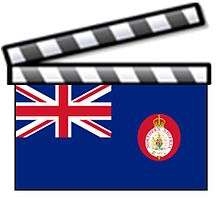Cinema of Northern Nigeria
| Cinema of Northern Nigeria | |
|---|---|
 | |
| Number of screens | 150 (2009)[1] |
| • Per capita | ??? |
| Produced feature films (2011) | |
| Fictional | 1000 |
| Number of admissions | |
| Total | 500,000, |
| Culture of Northern Nigeria |
|---|
 |
| History |
|
Literature
|
|
Media |
|
|
The cinema of Northern Nigeria informally called Kannywood. It is mainly based in Kano, Nigeria.
Like its people, the film-makers in Nigeria are divided largely along regional, and marginally ethnic and religious, lines. Thus, there are distinct film industries – each seeking to portray the concern of the particular section and ethnicity it represents. Although the films produced in the South mostly use English, the use of Pidgin-English, a creole form of English developed in the south has made southern films largey unattractive. The few ones rendered in the local language also hardly attracts much attention. Ibrahim, Muhsin. "Hausa film: Compatible or incompatible with Islam?,". Performing Islam.
History
The cinema of Northern Nigeria slowly evolved from the productions of RTV Kaduna and Radio Kaduna in the 1960s. Veterans like Dalhatu Bawa and Kasimu Yero pioneered drama productions that became popular with the Northern audience. In the 70's and 80's, Usman Baba Pategi and Mamman Ladan introduced the Hausa Comedy to the Northern audience.
The 1990's Bollywood influence
The 1990s saw a dramatic change in the Northern Nigerian cinema, eager to attract more Hausa audience who find Bollywood movies more attractive, Kannywood; a cinematic synthesis of Indian and Hausa culture evolved and became extremely popular. Turmin Danya ("The Draw"), 1990, is usually cited as the first commercially successful Kannywood film. It was quickly followed by others like Gimbiya Fatima and Kiyarda Da Ni. New actors like Ibrahim Mandawari and Hauwa Ali Dodo became popular and set the stage for the emergence of super-star like female actresses later on. The release of Turmin Danya written by Aminu Hassan Yakasai in March 1991 led to an upsurge in productions.[2] Sunusi Shehu of Tauraruwa Magazine created the term Kannywood in 1999 and it soon became the popular reference term for the industry.
2000's
By 2012, over 2000 film companies were registered with the Kano State Filmmakers Association.[3] In 2003, with the rise of the Izala and the coming to power of Ibrahim Shekarau; the then ultrareligious government of Kano initiated an iconoclastic campaign against Kannywood. Numerous movies deemed irreligious were censored and some film makers were jailed. This reversed some the gains Kannywood had made and allowed the Southern Nigerian film industry to supersede it.
In 2007, the Hiyana Affair: when the sex tape of a popular actress became public led to a severe backlash from the then Islamist government of Kano State under Ibrahim Shekarau. Shekarau went on to institute censorship with the support of the Izala Society and other Islamist organisations, Kannywood and the equally popular Hausa romantic novel industry were severely censored, actors, actresses and writers were jailed by the state government[2] and books and other media materials were burnt by the Governor himself.[2] In 2011 the replacement of the Islamist government by a much more liberal government led by the PDP led to a more favourable atmosphere for the Industry.
Today actors like Ali Nuhu, Ibrahim Maishunku, Adam A Zango, Sadiq Sani Sadiq, Hadiza Aliyu, Nafisa Abdullahi, Yakubu Mohammed and Rahma Sadau remain popular within the industry.
External links
- A database of Hausa films
- Ibrahim, Muhammad Muhsin (1 December 2013). "Hausa film: Compatible or incompatible with Islam?,". Performing Islam. Close Publishing. Retrieved 19 September 2014.
- ↑ Carmain, Mcain (2009). "The Newsletter of the West African Research Association (WARA)and the West African Research Center (WARC)" (Spring, 2009): 20.
- 1 2 3 Sheme, Ibrahim. "Bahaushe Mai Ban Haushi". Ibrahimsheme.blogspot.com. Retrieved 2015-02-08.
- ↑ Babagana M Gana (1 June 2012). "Hausa-English code-switching in Kanywood Films.". International Journal of Linguistics.